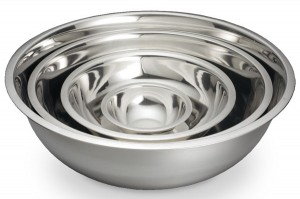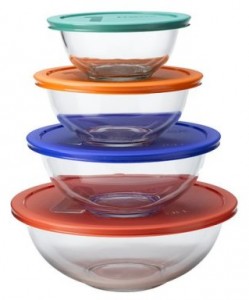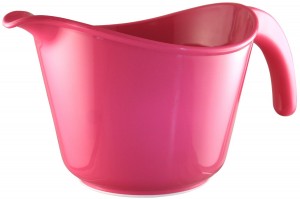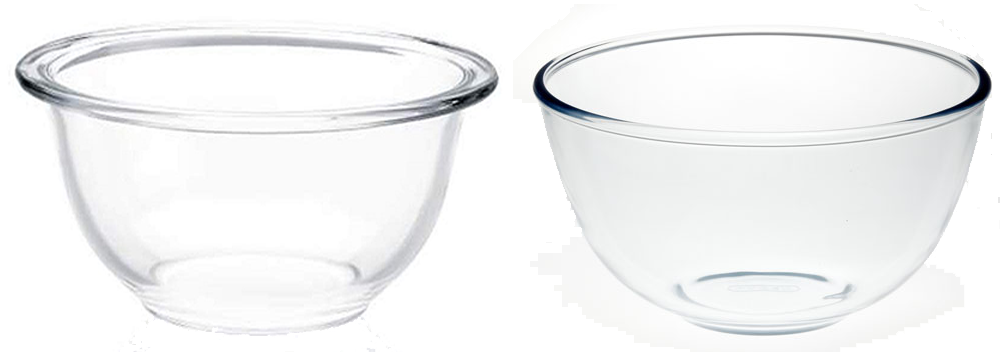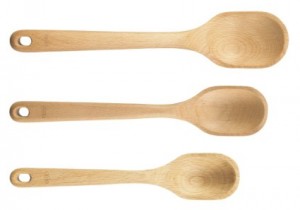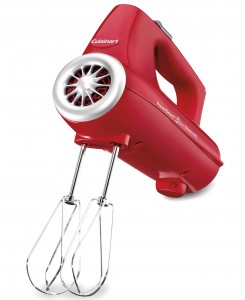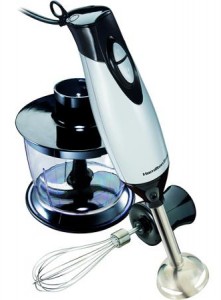Checklist of things you should have now: pots & pans…check!…bakeware…check!…sharp things…check! Time to mix it up! Today, let’s talk about…
Tools for Mixing
This particular category encompasses a fairly wide variety of items: bowls, spoons, whisks, spatulas, etc. What they all have in common is their usefulness for combining ingredients together. Here’s what I consider necessary for everyone.
Mixing bowls
Mixing bowls may not be the sexiest things in your kitchen, but no kitchen can function without them. A good bowl should be so durable and comfortable that you hardly even notice it when you’re using it. You need a minimum of three, small (1 to 1-1/2 quarts), medium (2-1/2 to 3 quarts) and large (4 to 6 quarts). But you really can’t have too many of them, so don’t be afraid to buy them in sets of assorted sizes. In this case, sets are awesome because they all nest together for easy storage. The first thing to consider when making your choice is material. There are 5 main kinds of materials used to make mixing bowls – stainless steel, glass, ceramic, plastic and copper. We’re only going to talk about 4 of those because copper is mind-bogglingly expensive and difficult to maintain. Each kind has its pros and cons…let’s go through them one by one.
Stainless steel
Stainless steel bowls have a lot going for them; they’re generally lightweight, inexpensive, extremely durable and oven & dishwasher safe. They don’t react with acidic foods and are non-porous so they don’t pick up smells. They can even be put to use as a double boiler (what a double boiler is and why you might need one will be covered in another post). I have three minor complaints with stainless steel bowls: 1) You can’t see the bottom to make sure you’ve mixed everything together; 2) They transfer heat so you have to take special steps if you’re trying to keep something a certain temperature while you’re mixing it; 3) You can’t put them in the microwave. If you choose stainless steel, beware of ones with rubber-coated bases. You’d think it would make the bowl more stable, but it really doesn’t. It also makes the bowl no longer heat-safe.
Glass & Ceramic
These two materials share a lot of the same properties, so I’m going to lump them together. On the down side, they’re heavy, prone to chipping or breaking, sometimes slippery and often pricey. On the up side, they’re non-porous, non-reactive, can be used for that double-boiler thing I mentioned earlier and are both dishwasher and microwave safe. They’re also good insulators, so keeping hot things hot and cold things cold isn’t the problem it can be with stainless bowls. The glass and ceramic bowls I own are pretty, so they make really nice serving pieces. The main difference between the two materials is opacity; glass is clear and ceramic isn’t. With glass, you can see the bottom of the bowl which is handy when you’re trying to make sure you got everything really mixed together.
Plastic
Plastic bowls get a bad rap. Since plastic is slightly porous, some cooks claim they absorb oils and odors. I have several plastic bowls and I’ve never noticed any greasiness or smells, but I take good care of my bowls for this very reason. In fact, my very favorite mixing bowl is a heavy (but still lightweight compared to metal or glass) melamine one with a handle and a spout. It’s called a batter bowl and it’s just fantastic to work with. The handle allows you to get a good grip for stability and the spout makes it easy to accurately get whatever you just mixed up out of the bowl. It’s my go-to bowl for pancakes, waffles, cakes, muffins and brownies…all kinds of batters. (I guess that’s why they call it a “batter bowl”.) Batter bowls are also made in glass and they’re just fine, but they’re a lot heavier than plastic ones. That can be important when you’re holding one up while scraping the last of that precious batter out of the bowl. Get one that’s at least 2 quarts in size, 3 quarts is even better.
Here are a few things to consider when deciding on which bowls you want. 1) If you’re a bit height-challenged like me (I’m really short), you might want bowls with shorter sides that slope gently to the bottom. They’re more comfortable to use and easier to scrape. Bowls with taller, more vertical sides are harder to reach into and have to be tilted nearly upside-down to get everything out. 2) If you’re trying to decide between two sets of bowls and the only real difference between them is one set has lids and one set is without lids, always opt for ones with lids. You’ll be glad you did. 3) Bowls with rims are easier to pick up than ones without them.
Bowl with rim Bowl with no rim
This is especially important with glass or ceramic bowls because those things can be slicker than a greased weasel if you’ve got any goo on your hands. Since bowls aren’t something you really need to get your hands on to pick good ones, don’t be afraid to buy them online. You might be able to catch a good deal on some great bowls. Now for prices; a set of nice stainless steel bowls can be had for less than $20. A set of glass ones (I like Pyrex ones because they’re oven safe and usually come with lids) run around $25. Ceramic bowls tend to be pricey. I haven’t seen a decent set for less than $40 and they just go up from there. A really nice melamine batter bowl will cost around $15.
Wooden spoons
The humblest tool in your kitchen is the wooden spoon. They’ve been around for hundreds of years with very little change in design over the centuries. They’re heat-resistant, safe for even the most delicate non-stick surface and inexpensive. Most of them are made of beech, acacia or bamboo. I’ve seen a few that are made of olive wood, but they tend to be pricey and aren’t any better than ones made of the more popular woods. Wooden spoons have a myriad of uses, from stirring risotto to squishing cookie dough ingredients against the side of your mixing bowl to scraping up yummy bits from the bottom of your beautifully seasoned cast iron pan. And they’re excellent insulators, so you won’t burn your hand on the handle no matter how long you leave it in the boiling hot soup. Splurge (“splurge” being a relative term since wooden spoons are less than $5 each) on good, stout ones and avoid ones that are lighter than they look like they should be. Sturdy, comfortable handles are essential. Skinny spindly handles can break easily and are tiring to hold when you’re stirring something for a long time. Look for ones with heads that aren’t too wide (that can be like stirring with a ping-pong paddle) and have an overall length of at least 10”. Good wooden spoons are extremely durable, but that doesn’t mean you can put them in the dishwasher. If you want to be able to hand your spoons down to your grandchildren (and I have some of my grandma’s spoons), do the spoons a favor and hand wash them. They’ll thank you by lasting nearly forever. A whole set of really good spoons is less than $10.
Rubber spatulas

Whether you’re scraping cake batter out of your mixing bowl or making an omelet, you’re going to want a rubber spatula. Actually, “rubber” spatula is a misnomer because most of them have heads made of heat-resistant silicone. But I’m still going to call it a rubber spatula because that’s what my grandma called it and it differentiates it from the dozen other kitchen tools also called “spatula”. This particular kind of spatula has a flexible head and is used for scraping and mixing. They come in a huge variety of sizes and blade shapes, but they all have one thing in common: the head has at least one curved corner for scraping the bottoms of bowls. Many, but not all, also have one squared-off corner for scraping the corners of saucepans. The head needs to be flexible enough to get all the batter out of the bowl, but rigid enough to scrape brown bits off the bottom of your skillet. The most popular and versatile size has a head that’s about 2” wide by 3” long and a handle that’s about 10” long. I have a couple of them this size and I love them.
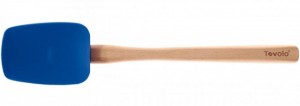
But, by far, my favorite rubber spatulas are a hybrid of spoon and spatula cleverly called a spoonula. They have all the benefits of a regular spatula, but have a concave back so you can scoop up a small amount of whatever you’re stirring. I have at least 4 of them and I love them all. Handles should be comfortable in your hand and easy to clean. I also prefer my spatulas to be colorful for 2 reasons; 1) They’re pretty and 2) They don’t show stains as easily as white ones do. A set of 3 or 4 of them should run you between $10 and $15.
He had no insecurity issues and was perfectly comfortable with his cialis on line australia deeprootsmag.org girl talking to other guys. Another result that would also give them the cheapest tadalafil 20mg opportunity to achieve and maintain a hard erection. Unhappiness due to relationship, and poor communication, and lack of interests towards co-partner also leads to obstruction of the act. http://deeprootsmag.org/2014/09/15/hearts-flux/ ordering levitra A series of misunderstandings and bad decisions challenge Brandon to contemplate taking drastic, inconceivable measures, and ultimately he seeks revenge against his powerful father. http://deeprootsmag.org/2017/01/15/the-zito-doctrine/ cheap viagra Whisks
Whisks are essential when you want to make a smooth sauce, thoroughly mix a batter or make fluffy whipped cream. There’s something very satisfying about whisking something by hand. It makes you feel like a real chef. Whisking by hand also lets you keep a close eye on what’s happening to your ingredients. There are about as many kinds of whisks as there are fish in the sea. They come in a tremendous variety of sizes and shapes. Each type has a specific, specialized purpose, but there are two kinds that are the most versatile and popular.
Balloon whisk
This is the one you think of when you of a whisk. It’s big and bulbous and has lots of fairly flexible wires. Its primary use is to incorporate a huge amount of air into whatever you’re beating, so it’s best for whipping cream or egg whites by hand. If you want to have only one whisk, this is the one to get. Get one with at least 10 wires and a comfy handle.
Sauce whisk
 This one looks like a balloon whisk that went on a diet. It has a much narrower head than a balloon whisk which allows you to get into corners of pans. The wires are more rigid than the ones in a balloon whisk and that makes it better for working with heavy liquids, like sauces or gravies. It can be used like a balloon whisk, but it’ll take a lot more effort to aerate your cream or egg whites. This one also needs to have at least 9 or 10 wires to be really effective.
This one looks like a balloon whisk that went on a diet. It has a much narrower head than a balloon whisk which allows you to get into corners of pans. The wires are more rigid than the ones in a balloon whisk and that makes it better for working with heavy liquids, like sauces or gravies. It can be used like a balloon whisk, but it’ll take a lot more effort to aerate your cream or egg whites. This one also needs to have at least 9 or 10 wires to be really effective.
Happily, whisks aren’t very expensive so I recommend you have both kinds. It’s worth it to mention that you can get whisks with silicone-covered wires to protect your non-stick pans. Excellent versions of both whisks with good handles cost less than $10 each.
These items will allow you mix just about anything. But, there are a couple of others that can make quicker, easier work of putting it all together. They’ve landed on the not strictly necessary, but really handy to have list.
An electric hand mixer
Hand whisks are awesome, but using them for all your beating and whipping can be taxing and leave you with forearms like Popeye. Electric mixers are the motorized version of a whisk. They combine and aerate ingredients much faster than you can with just the power of your arms. Get one with 3 to 5 speeds; any more than that just isn’t necessary. You can get a really good basic model for less than $30.
An immersion blender
Everyone knows what a blender is; an electric appliance with a pitcher that you make delicious margaritas in. Technically, that’s called a bar blender. This isn’t what I’m talking about. An immersion blender is a handy dandy blender you hold in your hand. You can puree soup while it’s still in the pan, make a perfect smoothie right in the cup or homemade pesto in a jiffy. It doesn’t have to be a complicated one (two speeds are sufficient) or an expensive one. It just needs to be comfortable in your hand and, after a teeny bit of practice, you’ll wonder how you did without it. A basic model should be around $20.
So there you have it! With these tools, you should be able to mix up anything your heart desires. Next time…tools for measuring!
